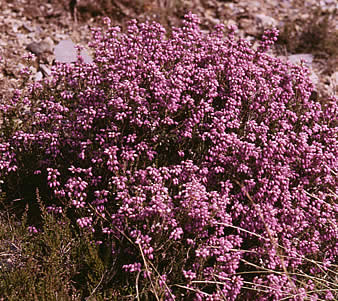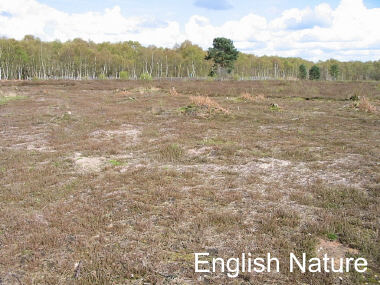HEATHLAND
LOCAL BIODIVERSITY ACTION PLAN
 Links to associated SAPs
Links to associated SAPs
None
Current Status
Heathland is defined as vegetation dominated by dwarf shrubs (usually Calluna vulgaris), and is found on both sandy mineral soils and peats. Heaths are usually found on acidic soils. Heaths below an altitude of 250m are described as lowland heathland while those above are upland heathland or moorland.
Heathlands are an internationally important habitat; they are almost always sub-seral communities and must be maintained by some form of management such as burning or grazing.
A large percentage of remaining European heathland is in Britain.
Heathlands were traditionally widespread in Europe until early this century, often being used for common grazing. However, since 1949, 40% of lowland British heath of acid soil has been lost by conversion to arable or intensive grazing, afforestation, building, or succession to scrub due to lack of proper management (NCC, 1984). There are now 31,000ha of lowland heathland remaining in England (Farrel, 1993). The Cheshire Heathland Inventory (Clarke, 1995), found 71 heathland sites in the administrative county, 26 (96ha) upland sites, comprising 10ha of wet heath and 86 .1ha of dry heath, and 45 (60ha) sites of lowland heath, comprising 11ha wet heath and 49ha of dry heath. In addition there are approximately 50ha of heathland on the Wirral peninsula.
Threats
-
Over-grazing on upland heath.
-
Reduced grazing and other management of lowland heath leading to birch and scrub invasivion (often birch and Scots pine).
-
Public pressure (eg. Recreation)
-
Development and further 'improvement'.
-
Uncontrolled fires.
-
Forestry.
-
Increased fertility due to agricultural run-off.
-
Increased nutrients in atmospheric deposition.
-
Natural outbreaks of heather beetle, which may be promoted by stress caused by pollution.
How are we helping to conserve Heathland in the Cheshire region?
-
88% of Cheshire's heathland is within the boundaries of SSSIs or SBIs.
-
The National Trust own 6 heathland sites. The Cheshire County Council's Countryside Management Service manages 9 sites. Two sites are in wildlife enhancement schemes. There are also 2 Cheshire Wildlife Trust reserves, 1 Woodland Trust reserve, 1 Scout camp, 1 site included in the Mersey Forest and 3 others owned by local authorities. 3 sites in private ownership are being managed as heathlands.
-
At least 5 heathland sites are in the Countryside Stewardship scheme.
-
Priority habitat identified for protection in the County Structure Plan 2001.
-
A Local BAP Action Group for heathlands was formed in 1998.
-
75ha of molinia dominated moorland, currently being reinstated to upland dwarf shrub heathland at High Moor, near Macclesfield.
-
Research is being carried out to investigate the effects of elevated atmospheric nitrogen pollution on heathland ecology (Manchester Metropolitan University)
-
North West Heathland Wildlife Enhancement Scheme (Natural England) initiated on Heswall Dales SSSI, to support management of areas in private ownership
Objectives, Targets and Actions
OBJECTIVES |
NATIONAL TARGETS |
LOCAL TARGETS |
| Maintain existing heathland |
Maintain and improve by management all existing lowland heathland (58000ha). |
As far as is practicable, prevent further loss and damage to existing heathland in Cheshire by 2005 |
| Restore heathland to suitable sites |
Encourage re-establishment by 2005 of a further 6 000ha of heathland, particularly where this links separate heathland areas |
As far as is practicable, restore existing Cheshire heathland to positive management by 2005 |
ACTIONS REQUIRED |
-
Provide advice and funding for maintenance of existing heathland.
-
Extend uptake of Environmental Stewardship and develop other grant schemes.
-
Establish heathland as one of the main end uses in restoration plans for sand quarries.
-
Appoint a 'champion' for the habitat in the Cheshire region.
-
Target should be set to double the area of lowland heath given appropriate management every five years from now until 2020.
-
Raise public awareness.
-
Secure commitment and funding for implementation of plans to create/restore heathland in the Delamere Forest and in the ECOnet phase 1 area.
-
Produce and agree a management plan for Little Budworth Common SSSI.
-
Ensure heathland is included as a local target Natural England’s Environmental Stewardship Scheme.
-
Press for heathland as one of the main end uses in restoration plans for sand quarries.
-
Improve collation of information on restoration/ reestablishment from site managers
-
Raise public awareness through local events
-
Assess success in meeting the action plan targets
-
Establish a heathland managers contact e-mail group for exchanging information.
|
Progress so far
| 2005 Action Completed |
|
| 2004 Action Completed |
-
Heathland restoration management carried out at Bickerton Hill and Lindow Common in 2004.
-
Plan produced in 2004 to restore 10 ha of heathland in the Delamere Forest.Plans to create up to 28 hectares of heathland included in the planning permissions for Crown Farm and Forest Hill quarries in 2004.
-
Proposals to create/restore 225 ha of heathland between Frodsham and Bickerton by 2010 included in Cheshire ECOnet Phase One feasibility study produced in 2004.
|
| 1997 - 2003 Action Completed |
-
An Action Committee has been formed to pool expertise and offer advice on heathland management and restoration.
-
Heathland is being put forward as a restoration option on suitable mineral extraction sites
-
An increased area of heathland is being managed under the Countryside Stewardship and Environmental Stewardship schemes.
-
Cheshire's heathland resource (both actual and potential) are included on the county's GIS database through the Life ECOnet Project.
-
A large area of heathland has been created by the National Trust on the Wirral in 2003.
|
How to find out more about Heathland
The Wirral Biodiversity Action Plan for Heathland can be seen at www.wirral.gov.uk/ed/biodiversity/heath.htm
UK BAP for Lowland Heathland - www.ukbap.org.uk/UKPlans.aspx?ID=15
UK BAP for Upland Heathland - www.ukbap.org.uk/UKPlans.aspx?ID=16
Contact details
| LBAP Chair |
Alun Evans, Cheshire County Council
Phone 01244 603177
|
| National Lead Partners |
Natural England
|
| National Contact for Lowland Heathland |
Isabel Alonso, Natural England |
| National Contact for Upland Heathland |
Mick Rebane, Natural England
Phone: 01733 455268
|
References & Glossary
English Nature (1993): Midland Meres and Mosses RAMSAR Citation.
HMSO (1995): Biodiversity: The UK Steering Group Report, Volume 2:Action Plans, London.
JNCC (1997): The Habitats Directive: selection of Special Areas of Conservation in the UK. JNCC Report No. 270.
English Nature (1998): Natural Area Profile, Meres and Mosses 27.
English Nature (1998): Natural Area Profile, Dark Peak.
English Nature (1998): Natural Area Profile, South West Peak.
English Nature (1998): Natural Area Profile, Urban Mersey Basin.
English Nature (1998):A Strategy for the conservation of the Meres and Mosses of Cheshire, Shropshire and Staffordshire.
English Nature (1999): Natural Areas in the North West Region, helping set the regional agenda for nature.


 Links to associated SAPs
Links to associated SAPs 